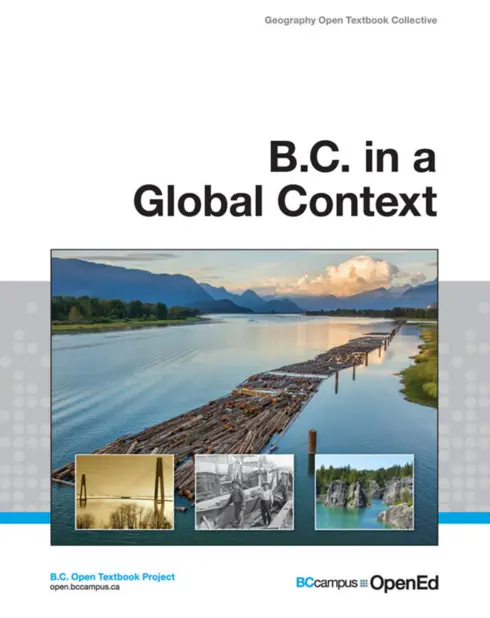
Formats Available
Conditions of Use
![]() Attribution
Attribution
CC BY
Reviews
Reviewed by Dimitar Dimitrov, Geography Instructor, Portland Community College on 12/29/21
The text is an interesting, informative, and comprehensive description of one of the most diverse and abundant with natural resources provinces in Canada, British Columbia. It covers several important topics, presented in eight chapters. Each... read more
![]()
![]()
![]()
![]()
![]()
Reviewed by Dimitar Dimitrov, Geography Instructor, Portland Community College on 12/29/21
Comprehensiveness
The text is an interesting, informative, and comprehensive description of one of the most diverse and abundant with natural resources provinces in Canada, British Columbia. It covers several important topics, presented in eight chapters. Each chapter starts with an introduction, and besides the main text includes case studies, as well as some sections that are very helpful to both students and instructors: a summary, key terms, suggested activities, and references and resources. As a whole, the text is well illustrated with tables and figures. One of the many merits of the text is the abundance of examples from the historical development of the region.
Content Accuracy
I didn’t find any inaccurate information in the textbook.
Relevance/Longevity
The textbook is up to date. Due to the constantly changing subject matter, the human geography parts (text, examples, maps, and figures) should be updated every three or four years.
Clarity
The textbook is clearly written and easily understandable even for students who are encountering the geography text for the first time.
Consistency
The text is consistent in terms of terminology and the framework.
Modularity
The chapters are arranged by topics, and each chapter is organized into smaller reading sections that can be easily assigned for individual or group work. All of the chapters include short introductions, a summary, key terms, suggested activities, and references and resources.
Organization/Structure/Flow
The textbook is organized in 8 chapters, each one covering a specific topic: 1. Urban Settlement in British Columbia. 2. Socio-Economics in British Columbia. 3. Aboriginal Issues in British Columbia. 4. Resources in British Columbia. 5. Food Systems in British Columbia. 6. Forestry in British Columbia. 7. Health Geography in British Columbia. 8. Physical Geography of British Columbia.
The flow is not traditional for regional geography texts, and the physical geography of the region is presented in the last chapter. Although the authors explain the reason for this unusual organization of the text in the Introduction, I still believe that the structure and the flow would be more logical if the chapter Physical Geography of British Columbia precedes the other chapters.
Interface
I didn’t find any interface issues. The textbook is very easy to navigate.
Grammatical Errors
The text is well-edited for grammar and I found no grammatical errors.
Cultural Relevance
I didn’t find any offensive language or culturally insensitive issues in both the text and the illustrations. All of the races, ethnicities, and cultural backgrounds are addressed with respect.
CommentsThe textbook includes some definitions of basic processes and phenomena, which the reader would expect to find in an introductory human geography textbook, not in a regional geography text. For example, the intro part of Chapter 1 includes definitions of city, demographic changes, economic changes, technological changes, and so on; the intro part of Chapter 2 provides definitions of GDP, GNI, PPP, etc.
The review of the contemporary urbanization in British Columbia, which I believe should be the core of Chapter 1, is presented in just one short paragraph.
There are no maps in two of the chapters: Chapter 1 Urban Settlement in British Columbia, and Chapter 6 Forestry in British Columbia.
Table of Contents
About the Book
Introduction
- 1. Urban Settlement in British Columbia
- 2. Socio-Economics in British Columbia
- 3. Aboriginal Issues in British Columbia
- 4. Resources in British Columbia
- 5. Food Systems in British Columbia
- 6. Forestry in British Columbia
- 7. Health Geography in British Columbia
- 8. Physical Geography of British Columbia
Qualitative Research Methods in Human Geography
Physical Geography Research Methods
How to Find Research Literature
About the Authors
Additional Credits
About the Book
This first year Geography textbook takes a holistic approach to Geography by incorporating elements of physical, human and regional geography, as well as bringing in methods and perspectives from spatial information science.. This textbook applies a fundamental geographical approach to understanding our globally changing world by looking at local processes which are linked to larger global processes and events. The textbook includes numerous case studies specific to British Columbia as well as a number of suggested service learning activities.
Over the course of four days in June, 2014, 5 faculty members from across British Columbia supported by a facilitator, librarian, researcher, illustrator, programmer and instructional designer, created this book. This involved drawing on our own research, teaching and experience and working with the team to put it all together into an online format; one which would be accessible to students and educators alike.
Beyond the unique way in which this book was created in a Book Sprint process, there are other elements of this book that make it unique. First, it takes a holistic approach to first year Geography, incorporating elements of Physical, Human, and Regional Geography, as well as bringing in methods and perspectives from Spatial Information Science.
Pedagogically, this book incorporates elements of service learning and suggested service learning activities recognizing that the study of Geography is deeply connected to the communities we live in. Many of the suggestions for service learning are illustrated through the use of case studies from across BC.
The book is aimed at a a first year or introductory Geography student, and would be suitable for a first year Geography course on BC.
